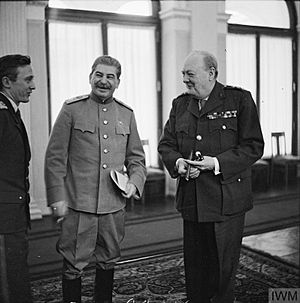Anglo-Soviet Agreement facts for kids
The Anglo-Soviet Agreement was an important deal signed by the United Kingdom and the Soviet Union on July 12, 1941. It was a promise to work together in World War II against Nazi Germany. This agreement happened soon after Germany invaded the Soviet Union in an attack called Operation Barbarossa. Both countries promised to help each other. They also agreed not to make a separate peace deal with Germany. This meant neither country would stop fighting Germany on its own.
The agreement was meant to last until the war against Germany ended. Its main ideas were helping each other and not making a separate peace. These ideas were similar to earlier agreements with other Allied countries. These early agreements later led to the Declaration by United Nations.
Contents
Why the Agreement Was Needed
Before this agreement, the Soviet Union and Germany had signed a deal called the Molotov–Ribbentrop Pact in August 1939. This was a non-aggression pact, meaning they promised not to attack each other. A secret part of this deal divided parts of Eastern Europe between them. In September 1939, Germany invaded Poland. Soon after, the USSR also invaded Poland from the east. This created a new border between their controlled areas.
However, on June 22, 1941, Germany suddenly attacked the USSR. This attack, known as Operation Barbarossa, stretched along the entire border. It went from the Baltic states down to Ukraine. The Soviet forces were not ready for such a massive attack. Their command system was badly hit. German forces quickly moved deep into Soviet lands. This sudden attack made the Soviet Union look for allies.
How the Agreement Was Made
At first, the UK and the Soviet Union were very suspicious of each other. They had difficult talks for three weeks to reach an agreement. The UK also talked with its allies like the US, Canada, Australia, and South Africa. Only after these discussions did they finalize the deal. This military alliance was set to last until the war with Germany was over.
The agreement was officially signed on July 12, 1941. Sir Stafford Cripps, who was the British Ambassador to the Soviet Union, signed for the UK. Vyacheslav Molotov, the Soviet Foreign Minister, signed for the USSR. The agreement did not need any further approval to become active.
What the Agreement Said
The Anglo-Soviet Agreement had two main parts:
- The two governments promised to give each other all kinds of help and support. This was for the war against Hitler's Germany.
- They also promised that during this war, they would not talk about or sign a ceasefire or peace treaty. They could only do so if both countries agreed.
What Happened After the Agreement
When the agreement was signed, the UK and the Soviet Union officially became allies against Germany. Winston Churchill, the British Prime Minister, said, "It is of course an alliance and the Russian people are now our allies."
Soon after, important things started happening:
- The Arctic convoys began. These were groups of ships from Britain that carried supplies to the Soviet Union.
- The UK and the Soviet Union also launched a joint Anglo-Soviet invasion of Iran. This opened up another important supply route to the USSR. In Iran, the ruler, Rezā Shāh, was removed from power. The new Shah, Mohammad Reza Pahlavi, then signed a special treaty with Britain and the Soviet Union in January 1942. This treaty helped the Allied war effort without direct military action.
The two main ideas of the agreement – helping each other and not making a separate peace – were very important. They were similar to earlier promises made in the Declaration of St James's Palace. These ideas later became the foundation for the Declaration by United Nations, signed in January 1942. The Anglo-Soviet Agreement was later made even stronger. It became the Anglo-Soviet Treaty of 1942, which was a political alliance set to last for 20 years.
Other Countries' Views
The United States saw the agreement as a sign. They believed the Soviet Union planned to help Poland, Czechoslovakia, and Yugoslavia become independent again after the war.
See also
- Allies of World War II
- Anglo-Soviet relations
- Anglo-Soviet Trade Agreement (1921)
- Atlantic Charter
- Diplomatic history of World War II


